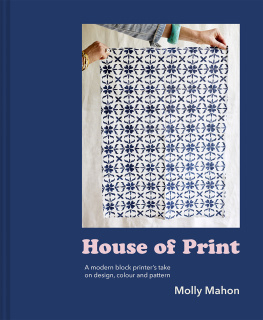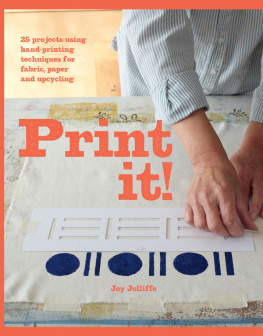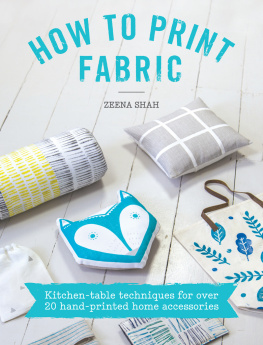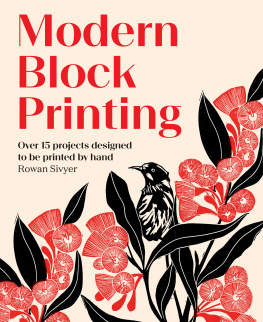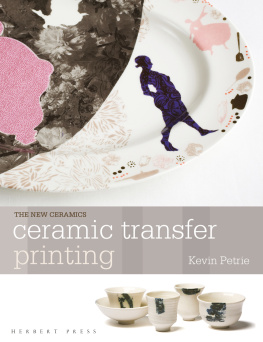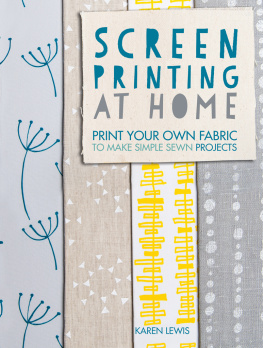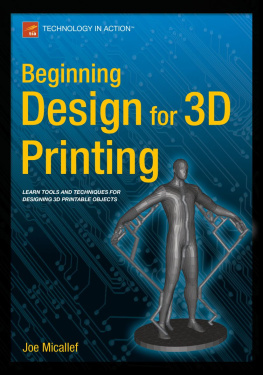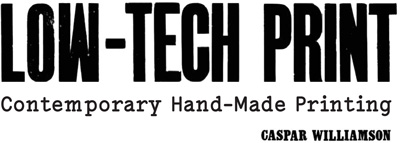
Laurence King Publishing

Published in 2013 by
Laurence King Publishing Ltd
361363 City Road, London,
EC1V 1LR, United Kingdom
T +44 (0)20 7841 6900
F + 44 (0)20 7841 6910
www.laurenceking.com
Text 2013 Caspar Williamson
Caspar Williamson has asserted his right under the Copyright, Designs and Patents Act 1988 to be identified as the author of this work.
This book was produced by Laurence King Publishing Ltd, London
All rights reserved. No part of this publication may be reproduced or transmitted in any form or by any means, electronic or mechanical, including photocopying, recording or any information storage or retrieval system, without permission from the publisher.
A catalogue record for this book is available from the British Library
ISBN: 978-1-78067-297-7
Design by StudioAparte, Barcelona Cover design by Pentagram
Printed in China
Foreword
I first connected with the author of Low-Tech Print when our paths crossed along the digital byway. It seems Caspar Williamson and I are kindred spirits of sorts. I had recently finished curating a book on a similar subject, titled Push Print, and we both make our living as creative professionals. The difference is Caspar was born in 1984, the same year Apple launched the Macintosh, while I began my career well before any digital wizardry was practised by most designers or art directors.
I moved from Ohio to New York City in 1984 for my first big city job. Once I arrived, it wasnt just the bright lights that dazzled me: I remember getting the first brief and the creative director telling me we could use six-colour digital printing. Id never even heard of such a thing and couldnt imagine what these magical fifth and sixth colours might actually look like! It was production shock and awe with a slickness and scale befitting the products we were pushing.
The very same year my brother Keith also set out on a new adventure. He left his job in a printing firms pre-press department to buy a little print shop that had been in small-town Salem, Ohio, since 1938. He longed to run his own place and be on-press instead of stuck in a darkroom all day. It was his dream, but the timing was not ideal with desktop publishing taking away more and more of the projects that were the lifeblood of local printers.
During visits to my hometown I would always stop by the shop to see how things were going. To me it was like stepping into some kind of Terry Gilliam fantasy land with a smell that was part paint thinner and part century-old wood. The vintage iron Chandler & Price platen letterpress and other strange and dangerous-looking contraptions were fascinating. It felt like Id discovered an ancient civilization that had been frozen in time by a volcano or other cataclysmic event.
As time went on, things became increasingly difficult for small-town printing shops. The shop did what it had to do, producing some torturous office materials. Keith and I would collaborate on more interesting projects when possible but time had caught up with the old place. At the turn of the twenty-first century it was looking like the dire predictions about prints demise just might come true.
Well, it turns out Keith was never that into the glossy print work after all. All the time the modernization was supposedly taking place, he was secretly buying antique printing gear. He began with what amounted to a working museum and then made it his hobby, adding pieces to the collection. He even acquired a Heidelberg Windmill letterpress like the one he had sold years before and placed it in the exact spot where the old machine had sat. Luckily Keith didnt just acquire, hoist, shine and grease his hefty mechanical marvels. He also spent years learning the tricks and techniques of the historic trade. After much counseling I convinced him that maybe it would be a good idea to share his personal playground with others who might also benefit from the cool toys. So we agreed that he get rid of anything even remotely new (except the Mac) and run a dedicated letterpress studio.
There was always something very appealing about the gritty, raw, tactile graphics of real ink on real paper. Who wouldnt love seeing their work in glorious spot colour? It turns out a lot of people agree and we find ourselves in the middle of a traditional print revival. This book will introduce you to some of todays top printmaking practitioners and explore the tools and techniques they use to produce beautiful contemporary work. Youll get an intimate look at the craft, culture and inspiring examples of art prints done through a variety of processes. Nothing fancy, just low tech at its highest form.
Jamie Berger
Creative Partner, Cranky Pressman
Salem, Ohio, USA
Introduction
Instantly accessible, yet infinitely complex, printmaking is an art form that opens its arms to anyone, yet defies limits with the breadth of its capabilities.
Low-Tech Print is an exploration of handmade printmaking techniques and the cultures they exist in today. It is an examination of the evolution of traditional printing disciplines, and how this has lead to a huge resurgence in the popularity of printmaking in recent years. Designers and creatives of all kinds are rediscovering and discovering for the first time the artistic opportunities on offer. This book documents printmaking work from all over the globe that not only showcases eye-catching examples from the crafts most exciting and influential practitioners, but also delves into the backgrounds and histories of traditional printmaking techniques, and the influences that have led to new developments in printing methods.
Artists, designers and creatives around the world have adapted traditional printmaking methods to suit their own modern-day purposes. Beside technical improvements leading to more efficient use of presses and materials, the methods and mechanics of printmaking machinery have remained unchanged for generations. Many of the machines used today outdate one, if not two World Wars either passed down from friends or relatives, or discovered and restored to their former, fully functioning glory. A new generation of printmakers is contributing to the preservation of our printing history. By continuing to use traditional printing techniques and machinery, they are ensuring that the medium will be around for the next generation to appreciate.
But what can explain the large increase in awareness of and demand for printmaking? The internet without doubt is the source of a lot of the answers to this question. Sites such as Etsy, Folksy and eBay provide a platform for individuals worldwide to sell and promote their work, giving worldwide exposure to the artistic diversity generated by traditional techniques. At the click of a mouse button, anyone can enjoy and educate themselves about once niche and specialist craft forms. Self-promotion and learning have never been more accessible, and craft-centred communities have never been so open and easy to join. Furthermore, relief printing, letterpress and screen-printing, mediums widely used in craft and textiles, have also been embraced by leading graphic designers and artists worldwide.
During the 12 months involved in the research and writing of this book, I have continually been blown away not only by the beautiful and varied range of material I have discovered, but also by the inspirational stories of the people behind the work. From each continent of the Earth, the stories have a common thread; in an over- saturated digital age, these most traditional of methods have allowed people to reconnect with the physical process of print that they have been pining for.
Next page







